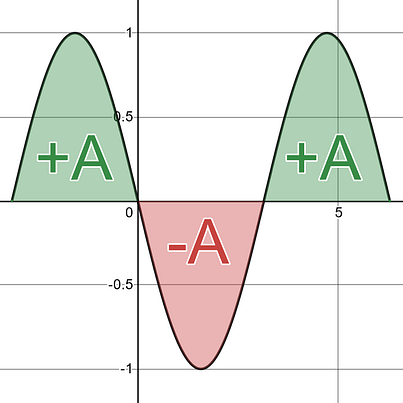Displacement vs. Distance Traveled
One of the most common physics integral applications comes in knowing the subtle distinction between whether the question is asking you to calculate the Displacement of an object (how far it moved from its original position), or if the question is asking you to calculate the Total Distance traveled (the total amount of movement).
This really is the third time learning how to apply a very similar use case. This integral application is the exact same as when you needed to know the difference between Net Area and Total Area, and knowing the difference between Net Accumulation and Total Accumulation.
|
Displacement = Net Accumulation = Net Area |
Distance = Total Accumulation = Total Area |
|
With displacementyou treat area above the x-axis as positive amounts and area below the x-axis as negative amounts. You then add all those areas together to get your displacement . |
With distanceyou treat ALL area as positive area. You do not care about above or below the x-axis . You want to know the full value of ALL the area between the curve and the x-axis , the total distance . This value will always be positive or zero. |
|
|
|
|
Displacement = A– A+ A = +1A |
Total Area = A + A + A = +3A Always a POSITIVE value. |
|
Real World : You would refer to this as your displacement . You took one meter forward, then one meter back, and then one meter forward. Therefore, your displacement is that you have moved forward 1 meter from your starting location. |
Real World : You would refer to this as your total distance traveled. You took one meter forward, then one meter back, and then one meter forward. Therefore, you traveled a total distance of 3 meters since you left your starting location. |



